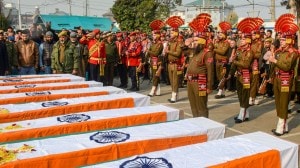Delhi govt moves Supreme Court: Legal history of Delhi’s water dispute with other states
Despite taking several measures, the Delhi government has not been able to tackle the water shortage issue. This has precipitated an emergency in the form of a full-fledged water and sanitation crisis and has necessitated an emergent solution, according to the government’s petition.
 Residents fill water from a tanker amid water crisis, at the Vivekanand Camp in Chanakyapuri area of New Delhi, Friday, May 31, 2024. (PTI Photo/Kamal Singh)
Residents fill water from a tanker amid water crisis, at the Vivekanand Camp in Chanakyapuri area of New Delhi, Friday, May 31, 2024. (PTI Photo/Kamal Singh)The Delhi government on Friday (May 31) approached the Supreme Court seeking urgent directions to Haryana and Himachal Pradesh to release more water into the National Capital Territory (NCT) region. The move has come due to an unprecedented surge in temperatures, leading to the rising demand for water.
This is not the first time that the Delhi government has approached the SC over its water woes.
Why has the Delhi government approached the SC?
Despite taking several measures, the Delhi government has not been able to tackle the water shortage issue. This has precipitated an emergency in the form of a full-fledged water and sanitation crisis and has necessitated an emergent solution, according to the government’s petition.
The AAP government has also said that Himachal Pradesh has agreed to share its surplus water with Delhi, but the water will have to be transported through the Wazirabad barrage with the Haryana government’s cooperation, which isn’t being provided currently.
Adding that the water levels in the Sonia Vihar and Bhagirathi barrages, the other primary sources for Delhi-NCR, are operating at full capacity, the government contended that an increase can only be considered at the Wazirabad barrage. However, despite requests to Haryana to release surplus water, there has been no positive response.
Stating that additional water supply is necessary due to Delhi-NCR’s large workforce and migrant population, the government added that it was only seeking relief as a “stop-gap arrangement” until the monsoon season’s arrival.
What were the other instances?
On March 31, 1995, the SC passed an interim order acting on a plea, filed by one Commodore S D Sinha, which sought direction to Haryana to maintain a regular flow of water in the Yamuna River amid drinking water shortage in Delhi.
The order said, “Delhi which is in dire need of water is to be given its allocation of water with immediate effect. We, therefore, direct all the parties to the Memorandum of Understanding to assure that sufficient water, which… is about 2 ½ times of the seasonal allocation, is released from Tajewala Head so that Delhi gets 0.076 BCM [It is this quantity of water, Delhi has to get under the MoU, between March to June.] for its consumption during the period March to June 1995.”
Signed by the Chief Ministers of five basin states on May 12, 1994, including Haryana, Delhi, Uttar Pradesh, Rajasthan, and Himachal Pradesh, the memorandum dealt with the allocation of Yamuna water amongst the co-basin states of the Upper Yamuna Basin by the Board under the Department of Water Resources, River Development, and Ganga Rejuvenation, Union Ministry of Jal Shakti. It stated that when the availability of water is less than the assessed quantity, the drinking water allocation of Delhi has to be met first, while the balance will be distributed among the remaining states in proportion to their allocations.
The bench had also issued directions to Haryana and Uttar Pradesh, through their Chief Secretaries of the Irrigation Departments, to release the water for consumption of Delhi from Tajewala Head with effect from April 6, 1995. However, the court made it clear that its order was an “interim measure till the time the members of the Board and the Review Committee” were appointed and it became functional.
In the aftermath of the 1995 ruling, two contempt petitions were filed before the SC, one by Delhi Water Supply and Sewage Disposal Undertaking and the other by Commodore Sinha, for wilful violation of the order dated March 31, 1995. These culminated in the 1996 ruling in Delhi Water Supply and Sewage Disposal Undertaking v. State of Haryana.
What did the SC rule in 1996?
Disposing of the contempt pleas, a bench of Justices Kuldeep Singh and BL Hansaria on February 29, 1996, ruled, “Delhi shall continue to get as much water for domestic use from Haryana through River Yamuna which can be consumed and filled in the two water reservoirs and treatment plants at Wazirabad and Hyderpur. Both the Wazirabad and Hyderpur reservoirs shall remain full to their capacity from the water supplied by Haryana through River Yamuna.”
The court also directed Haryana not to obstruct the supply of water to Delhi as directed by it, while adding that its order was independent of the MoU signed between the states.
“We, therefore, close the proceeding by requiring Haryana to make available the aforesaid quantity of water to Delhi throughout the year. Let it be made clear that any violation of this direction would be viewed seriously and the guilty persons would be dealt with appropriately,” the court said.
However, in 2021, when the water level in the Wazirabad pond, which supplies water to treatment plants in the city, dipped to 667 feet, the Delhi Jal Board (DJB) filed a petition before the top court alleging willful disobedience of the 1996 ruling by the Haryana government.
What was Delhi’s case against Haryana?
In its plea, the DJB said that the Haryana government was stopping the water supply to the national capital and not releasing 120 million gallons of water per day. However, the Haryana government said that the situation in Delhi was caused by “internal mismanagement.”.
On July 23, 2021, a bench of Justices L Nageswara Rao, A S Bopanna, and V Ramasubramanian dismissed the batch of contempt pleas filed by the Delhi Jal Board, seeking action against the Haryana government.
Saying that the 1996 order was passed as “an interim measure till the time the members of the Board and the Review Committee were appointed” and it became functional, the court said the Delhi government couldn’t resort to the same now owing to the large-scale infrastructural developments that have taken place since February 1996. For instance, the court noted that since the 1996 order, three additional water treatment plants have been set up at Bawana, Dwarka, and Okhla.
Dismissing the Delhi government’s case, the court said, “The Petitioner has failed to make out any case for contempt against the Respondents. The Petitioner is cautioned to be careful in filing petitions repeatedly for a relief which has been rejected by this Court on earlier occasions.”



- 01
- 02
- 03
- 04
- 05


































